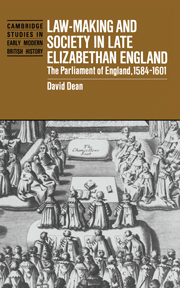Book contents
- Frontmatter
- Contents
- Acknowledgements
- Note to the reader
- List of abbreviations
- Introduction
- 1 Initiation and procedure
- 2 Supply and the general pardon
- 3 The crown and the state
- 4 Religion and the church
- 5 The commonweal
- 6 Law reform
- 7 Private legislation
- 8 Expiring laws continuance acts
- Epilogue: the Parliament of 1604
- Conclusion
- Index of acts
- Index of bills
- General index
8 - Expiring laws continuance acts
Published online by Cambridge University Press: 14 September 2009
- Frontmatter
- Contents
- Acknowledgements
- Note to the reader
- List of abbreviations
- Introduction
- 1 Initiation and procedure
- 2 Supply and the general pardon
- 3 The crown and the state
- 4 Religion and the church
- 5 The commonweal
- 6 Law reform
- 7 Private legislation
- 8 Expiring laws continuance acts
- Epilogue: the Parliament of 1604
- Conclusion
- Index of acts
- Index of bills
- General index
Summary
The peers and MPs attending the later Elizabethan parliaments did not only enact law, they also repealed law. There were two ways of doing this. One was simply to introduce a new bill repealing the unwanted act, a method that involved all the expense and time of getting an enactment through parliament. In the case of private acts, there was little choice because almost all private acts were made in perpetuity. In the case of public acts, however, there was the chance that the act had not been made permanent but carried a time-limitation clause. Instead of a specific bill of repeal, the act could be omitted from the list of statutes being renewed in the expiring laws continuance act; the law would simply be allowed to lapse.
In the last six Elizabethan parliaments sixty-six acts were made perpetual; thirty-one carried some limitation of time. The most common limitation was to keep the statute in force until the end of the next session of the next parliament, the formula used in twenty-three of the thirty-one time-limited acts. One, an act of 1597–8 concerning labourers, was to remain in force until a full year after the end of the next session of the next parliament. The remaining seven statutes were to continue for periods of between three and ten years, and then until the end of the next parliament. In contrast to the early Elizabethan sessions, no act was limited to the duration of the Queen's life; this was now a much more sensitive issue.
- Type
- Chapter
- Information
- Law-Making and Society in Late Elizabethan EnglandThe Parliament of England, 1584–1601, pp. 259 - 276Publisher: Cambridge University PressPrint publication year: 1996

